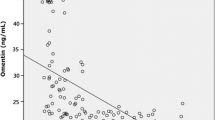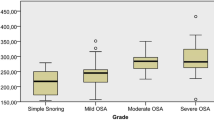Abstract
We aimed to compare serum levels of the inflammatory mediators including C-reactive protein (CRP), tumor necrosis factor-α (TNF-α), and asymmetric dimethylarginine (ADMA) in chronic obstructive pulmonary disease (COPD), obstructive sleep apnea syndrome (OSAS), and their coexistence called overlap syndrome (OVS). In addition, we planned to investigate changes of these mediators with the treatment of continuous positive airway pressure (CPAP) in OSAS and OVS. CRP, TNF-α, and ADMA levels were analyzed by ELISA method from blood samples withdrawn from patients with COPD (N = 25), OVS (N = 25), and moderate- to severe-stage OSAS (N = 25). First blood samples were taken in the morning after polysomnography application, and second blood samples were taken from OSAS and OVS patients who underwent regular CPAP treatment. In comparison of three groups prior to CPAP treatment, ADMA level in OSAS were significantly lower than in COPD (p = 0.009), but CRP and TNF-α were similar among groups. When we compared the parameters before and after CPAP treatment, the level of CRP in both OSAS and OVS decreased significantly (p = 0.02, p = 0.04), whereas TNF-α and ADMA levels did not display any significant differences. A decrease of serum CRP level in OVS and OSAS groups following effective CPAP treatment shows that CPAP is an effective treatment method for systemic inflammation.



Similar content being viewed by others
References
The Global Initiative for Chronic Obstructive Lung Disease (GOLD). Global strategy for diagnosis, management, and prevention of chronic obstructive pulmonary disease. Update 2011. Available from: http://www.goldcopd.org/uploads/users/files/GOLD_Report_2011_Feb21.pdf (accessed on 07 June, 2012).
Lurie, A. 2011. Obstructive sleep apnea in adults: epidemiology, clinical presentation, and treatment options. Advances in Cardiology 46: 1–42.
Kanbay, A., E. Kaya, H. Buyukoglan, N. Ozdogan, M.G. Kaya, F.S. Oymak, I. Gulmez, R. Demir, and O. Kokturk. 2011. Serum gamma-glutamyl transferase activity is an independent predictor for cardiovascular disease in obstructive sleep apnea syndrome. Respiratory Medicine 105: 637–642.
Fava, C., M. Montagnana, E.J. Favaloro, G.C. Guidi, and G. Lippi. 2011. Obstructive sleep apnea syndrome and cardiovascular diseases. Seminars in Thrombosis and Hemostasis 37: 280–297.
McNicholas, W.T. 2009. Chronic obstructive pulmonary disease and obstructive sleep apnea: overlaps in pathophysiology, systemic inflammation, and cardiovascular disease. American Journal of Respiratory and Critical Care Medicine 180(8): 692–700.
Gozal, D., and L. Kheirandish-Gozal. 2008. Cardiovascular morbidity in obstructive sleep apnea: oxidative stress, inflammation, and much more. American Journal of Respiratory and Critical Care Medicine 177: 369–375.
Sin, D.D., and S.F.P. Man. 2005. Chronic obstructive pulmonary disease as a risk factor for cardiovascular morbidity and mortality. Proceedings of the American Thoracic Society 2: 8–11.
Iber, C., Ancoli-Israel, S., Chesson, A., Quan, S.F., editors. 1st ed. Westchester, IL: American Academy of sleep medicine; 2007. The AASM manual for the scoring of sleep and associated events: rules, terminology, and technical specification.
Karadag, F., S. Kirdar, A.B. Karul, and E. Ceylan. 2008. The value of C-reactive protein as a marker of systemic inflammation in stable chronic obstructive pulmonary disease. European Journal of Internal Medicine 19: 104–108.
Wang, S., F. Xu, and Y. Chen. 2000. Detection and significance of IL-8, 6, TNF-alpha in sputa from patients with COPD. Zhonghua Jie He He Hu Xi Za Zhi 23: 465–467.
Gan, W.Q., S.F. Man, A. Senthilselvan, and D.D. Sin. 2004. Association between chronic obstructive pulmonary disease and systemic inflammation: a systematic review and a meta-analysis. Thorax 59: 574–580.
Stankiewicz, W., M.P. Dabrowski, A. Chcialowski, and T. Plusa. 2002. Cellular and cytokine immunoregulation in patients with chronic obstructive pulmonary disease and bronchial asthma. Mediators of Inflammation 11: 307–312.
Vernooy, J.H., M. Kucukaycan, J.A. Jacobs, N.H. Chavannes, W.A. Buurman, M.A. Dentener, and E.F. Wouters. 2002. Local and systemic inflammation in patients with COPD: soluble tumor necrosis factor receptors are increased in sputum. American Journal of Respiratory and Critical Care Medicine 166: 1218–1224.
Yokoe, T., K. Minoguchi, H. Matsuo, H. Minoguchi, G. Yoshino, T. Hirano, and M. Adachi. 2003. Elevated levels of C-reactive protein and interleukin-6 in patients with obstructive sleep apnea syndrome are decreased by nasal continuous positive airway pressure. Circulation 107: 1129–1134.
Shamsuzzaman, A.S., M. Winnicki, P. Lanfranchi, R. Wolk, T. Kara, V. Accurso, and V.K. Somers. 2002. Elevated C-reactive protein in patients with obstructive sleep apnea. Circulation 105: 2462–2464.
Can, M., S. Açikgöz, G. Mungan, T. Bayraktaroğlu, E. Koçak, B. Güven, and S. Demirtas. 2006. Serum cardiovascular risk factors in obstructive sleep apnea. Chest 129: 233–237.
Firat Guven, S., M.H. Turkkani, B. Ciftci, T. Ulukavak Ciftci, and Y. Erdogan. 2012. The relationship between high-sensitivity C-reactive protein levels and the severity of obstructive sleep apnea. Sleep & Breathing 16: 217–221.
Boudjeltia, K.Z., A.V. Meerhaeghe, S. Doumit, M. Guillaume, P. Cauchie, D. Brohée, M. Vanhaeverbeek, and M. Kerkhofs. 2006. Sleep apnoea–hypopnoea index is an independent predictor of high-sensitivity C-reactive protein elevation. Respiration 73: 243–246.
Teramoto, S., H. Yamamoto, and Y. Ouchi. 2003. Increased C-reactive protein and increased plasma interleukin-6 may synergistically affect the progression of coronary atherosclerosis in obstructive sleep apnea syndrome. Circulation 107: 40–43.
Kanbay, A., O. Kokturk, T. Ulukavak Ciftci, Y. Tavil, and N. Bukan. 2008. Comparison of serum adiponectin and tumor necrosis factor-alpha levels between patients with and without obstructive apnea syndrome. Respiration 76: 324–330.
Nijveldt, R.J., T. Teerlink, C. van Guldener, H.A. Prins, A.A. van Lambalgen, C.D. Stehouwer, J.A. Rauwerda, and P.A. van Leeuwen. 2003. Handling of asymmetrical dimethylarginine and symmetrical dimethylarginine by the rat kidney under basal conditions and during endotoxaemia. Nephrology, Dialysis, Transplantation 18: 2542–2550.
Abbasi, F., T. Asagmi, J.P. Cooke, C. Lamendola, T. McLaughlin, G.M. Reaven, M. Stuehlinger, and P.S. Tsao. 2001. Plasma concentrations of asymmetric dimethylarginine are increased in patients with type 2 diabetes mellitus. The American Journal of Cardiology 88: 1201–1203.
Millatt, L.J., G.S. Whitley, D. Li, J.M. Leiper, H.M. Siragy, R.M. Carey, and R.A. Johns. 2003. Evidence for dysregulation of dimethylarginine dimethylaminohydrolase I in chronic hypoxia-induced pulmonary hypertension. Circulation 108: 1493–1498.
Chen, G.F., N.C. Moningka, J.M. Sasser, S. Zharikov, M. Cunningham Jr., Y.L. Tain, I.F. Schwartz, and C. Baylis. 2012. Arginine and asymmetric dimethylarginine in puromycin aminonucleoside-ınduced chronic kidney disease in the rat. American Journal of Nephrology 35: 40–48.
Barceló, A., M. de la Peña, O. Ayllón, M.V. Vega-Agapito, J. Piérola, G. Pérez, C. González, A. Alonso, and A.G. Agustí. 2009. Increased plasma levels of asymmetric dimethylarginine and soluble CD40 ligand in patients with sleep apnea. Respiration 77: 85–90.
Ozkan, Y., H. Firat, B. Simşek, M. Torun, and S. Yardim-Akaydin. 2008. Circulating nitric oxide (NO), asymmetric dimethylarginine (ADMA), homocysteine, and oxidative status in obstructive sleep apnea-hypopnea syndrome (OSAHS). Sleep & Breathing 12: 149–154.
Kohler, M., L. Ayers, J.C.T. Pepperell, K.L. Packwood, B. Ferry, N. Crosthwaite, S. Craig, M.M. Siccoli, R.J. Davies, and J.R. Stradling. 2009. Effects of continuous positive airway pressure on systemic inflammation in patients with moderate to severe obstructive sleep apnoea: a randomised controlled trial. Thorax 64(1): 67–73.
Steiropoulos, P., I. Kotsianidis, E. Nena, V. Tsara, E. Gounari, O. Hatzizisi, G. Kyriazis, P. Christaki, M. Froudarakis, and D. Bouros. 2009. Long-term effect of continuous positive airway pressure therapy on inflammation markers of patients with obstructive sleep apnea syndrome. Sleep 32: 537–543.
Ohike, Y., K. Kozaki, K. Iijima, M. Eto, T. Kojima, E. Ohga, T. Santa, K. Imai, M. Hashimoto, M. Yoshizumi, and Y. Ouchi. 2005. Amelioration of vascular endothelial dysfunction in obstructive sleep apnea syndrome by nasal continuous positive airway pressure—possible involvement of nitric oxide and asymmetric NG, NG-dimethylarginine. Circulation Journal 69: 221–226.
Mansour, H.A.K.A., A. Fathy, and H. Aref. 2011. Effect of nasal continuous positive airway pressure on inflammatory mediators in patients with overlap syndrome. Egyptian Journal of Ear, Nose, Throat and Allied Sciences 12: 99–104.
Acknowledgments
The authors express sincere gratitude to Assoc. Prof. Reha Demirel for his contributions and statistical support and all the patients who participated in this study.
Conflict of Interest
We declare that this study was financially supported by the Scientific Research Projects Committee, Rectorate of Afyon Kocatepe University, Afyonkarahisar, Turkey.
Author information
Authors and Affiliations
Corresponding author
Additional information
All the authors contributed equally to this work.
Rights and permissions
About this article
Cite this article
Nural, S., Günay, E., Halici, B. et al. Inflammatory Processes and Effects of Continuous Positive Airway Pressure (CPAP) in Overlap Syndrome. Inflammation 36, 66–74 (2013). https://doi.org/10.1007/s10753-012-9520-z
Published:
Issue Date:
DOI: https://doi.org/10.1007/s10753-012-9520-z




